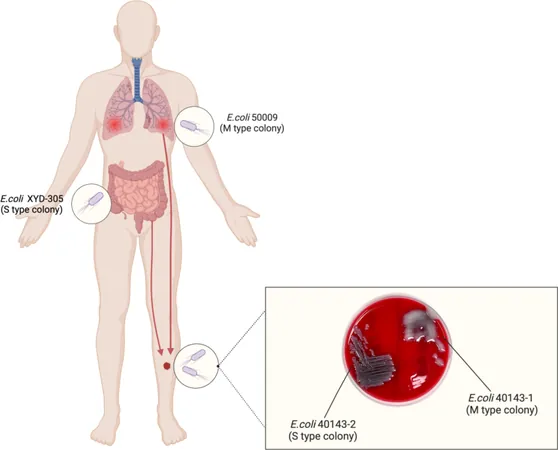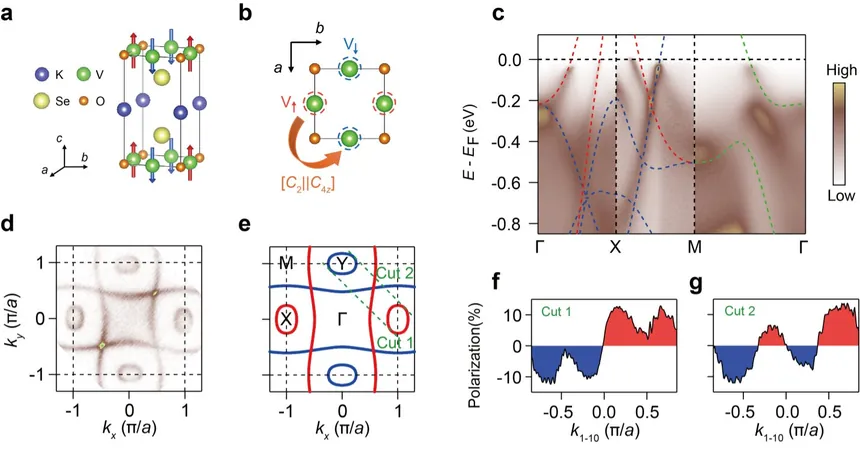
Uncovering the Hidden Secrets of E. coli: A Surprising Case of Strain Variability in Human Wounds
2025-03-31
Author: Wei
Introduction
Escherichia coli, popularly known as E. coli, is far from just a commensal bacterium—it possesses incredible adaptability, allowing it to thrive in diverse environments and even cause severe infections. The presence of morphological variants, including smooth and mucoid forms, reflects distinct infection capabilities and differing responses to antibiotics. This report dives into a captivating case study that involved an astonishing discovery of two genetically related E. coli strains isolated from the same patient, revealing the complexities of infection management.
Case Overview
A 70-year-old woman, already battling a lung infection and suffering from a leg wound, became the subject of an intriguing investigation when two forms of E. coli were isolated from her. A mucoid strain was retrieved from her wound and sputum, while a smooth strain was discovered in a rectal swab. Whole-genome sequencing (WGS) linked these variants genetically, indicating they were closely related despite their morphological differences. Alarmingly, both strains displayed resistance to β-lactam and quinolone antibiotics, complicating her treatment plan.
After initiating treatment with Piperacillin/Tazobactam and providing meticulous wound care, the patient's condition improved significantly, culminating in full recovery after a month.
The Marvel of E. coli Variability
This case underscores E. coli's remarkable phenotypic plasticity, which can drastically influence infection treatment and management. While many E. coli strains pose minimal threat, others, especially in immunocompromised patients, can morph into virulent forms capable of evading the immune system and surviving antibiotic treatments. For instance, the mucoid phenotype, identified by its thick polysaccharide capsule, is often linked to heightened resistance against immune responses and antibiotics—a trait which raises alarms for hospital stability.
Interestingly, similar phenomena have been noted in other bacteria like Klebsiella pneumoniae, where different colony morphotypes adapt to varied environmental pressures. The existence of both mucoid and smooth forms from a singular source highlights the bacterium's capacity to adapt and potentially switch between forms under the influence of selective pressures, such as antibiotic exposure or the host's immune response.
An In-depth Look at the Patient’s Condition
Upon examination, the patient's wound showed significant signs of infection: redness, swelling, and purulent discharge, further confirmed by elevated inflammatory markers (CRP and IL-6 levels). The clinical concern escalated with the identification of two distinct E. coli strains from her system—indicative of an extended-spectrum β-lactamase (ESBL)-producing infection.
Insights gained through virulence testing revealed that strain 40143-1, the mucoid variant, exhibited considerably higher pathogenicity compared to the smooth strain (40143-2). Despite both strains’ resistance profiles complicating treatment outcomes, understanding these differences is crucial for developing effective therapeutic strategies.
Conclusion
This remarkable case of simultaneous E. coli variant isolation reinforces the importance of recognizing bacterial adaptability in clinical settings. The dynamic relationship between infection phenotype and treatment response calls for deeper investigation into genetic mechanisms governing these variations. Moreover, as E. coli continues to present new challenges in infection control, the pressing need for advanced and tailored treatment strategies becomes unmistakably clear. Researchers and healthcare professionals alike must prepare for the complexities that come with the ever-evolving nature of pathogenic bacteria, particularly in increasingly vulnerable patient populations.
In closing, unraveling the complexities of E. coli can not only inform better treatment protocols but also safeguard against future outbreaks of multifaceted infections. What other hidden secrets could E. coli be holding? The inquiry continues!



 Brasil (PT)
Brasil (PT)
 Canada (EN)
Canada (EN)
 Chile (ES)
Chile (ES)
 Česko (CS)
Česko (CS)
 대한민국 (KO)
대한민국 (KO)
 España (ES)
España (ES)
 France (FR)
France (FR)
 Hong Kong (EN)
Hong Kong (EN)
 Italia (IT)
Italia (IT)
 日本 (JA)
日本 (JA)
 Magyarország (HU)
Magyarország (HU)
 Norge (NO)
Norge (NO)
 Polska (PL)
Polska (PL)
 Schweiz (DE)
Schweiz (DE)
 Singapore (EN)
Singapore (EN)
 Sverige (SV)
Sverige (SV)
 Suomi (FI)
Suomi (FI)
 Türkiye (TR)
Türkiye (TR)
 الإمارات العربية المتحدة (AR)
الإمارات العربية المتحدة (AR)